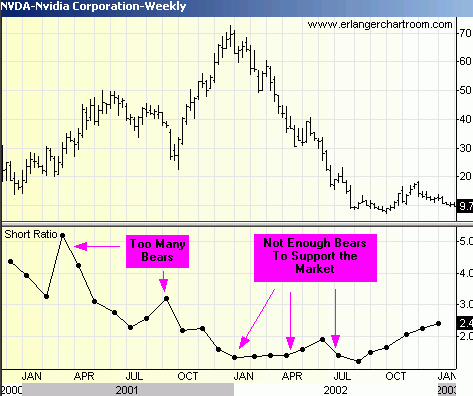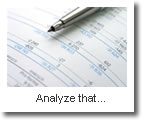The Sentiment Factor
Over time sentiment tends to swing from one excess to the other. We measure such swings by observing short sellers and options traders.
Short selling statistics describe at any point in time the level of shares short on a particular stock. Such “short interest” is typically divided by average daily volume of trading, to come up with a short ratio. Essentially, a short ration is a calculation representing the number of days it would take to cover all the existing short interest is all the trading were short covering. So, if a stock had a short ratio of 3.45, it would take that many days of trading to cover all the shares short. The higher the short ratio, the more bearish the sentiment is on a particular stock . Therefore, the lower the short ratio, the more bullish the sentiment is on a particular stock:

This chart of NVDA (NVIDEA Corp) shows the rise and fall of short selling intensity, as expressed by the Short Ratio in NVDA shares. There were way too many short sellers in January of 2001. It took a whole year before the shorts were squeezed out of the market by rising prices. Every uptick is an adverse move for short sellers, who's theoretical loss is unlimited. In actuality, margin rules for short sellers force them to come up with more capital, or to cover (in this case but back) the shares they sold short. Selling short is the reverse of the normal “buy then sell” action by most investors who bet on a stock's potential appreciation. Short sellers “sell first then buy later”, hoping to exploit a potential decrease in the stock's price. Note that once the short sellers were cleaned out at the top in January of 2002, the stock began a slide that lasted 10 months and ate away over 86% of the stocks value. The irony is that short sellers were too afraid too short on the way down, and didn't start to nibble on the short side until it was all over.
What is a Squeeze Play?
You've seen it a thousand times. A crowd of short sellers suddenly covering in a panic and sending the market soaring. Or a herd of bulls suddenly stampeding for the exits and pushing the market over a cliff. That's the market turning against the majority at risk – squeezing them out of their positions. As investors rush for the exits, they fuel the market's momentum! It happens all the time – in indexes, in sectors, in industry groups, and of course in individual stocks and exchange traded funds (ETFs.)
For those who can see squeeze plays unfold, it's like being a toll collector on a bridge where losers must cross the bridge to get out of their positions. In effect, each one will have to pay you to get out!
Squeeze plays are crowd driven events. That's what makes the potential so big. Users of sentiment indicators can see the psychology of the crowd when others cannot. Here's how…
From the view of a trader or investor, a “squeeze play” is determined by the observation of 2 factors – excess sentiment and adverse price action.
The observation of sentiment has been a well known advantage for those willing to do the hard work required to see the swings between excess bullishness and excess bearishness. Two key forms of sentiment data include: short selling statistics and the commitment of options traders. The advantage of these data is that they are stock specific and uncover bullish and bearish bets.

